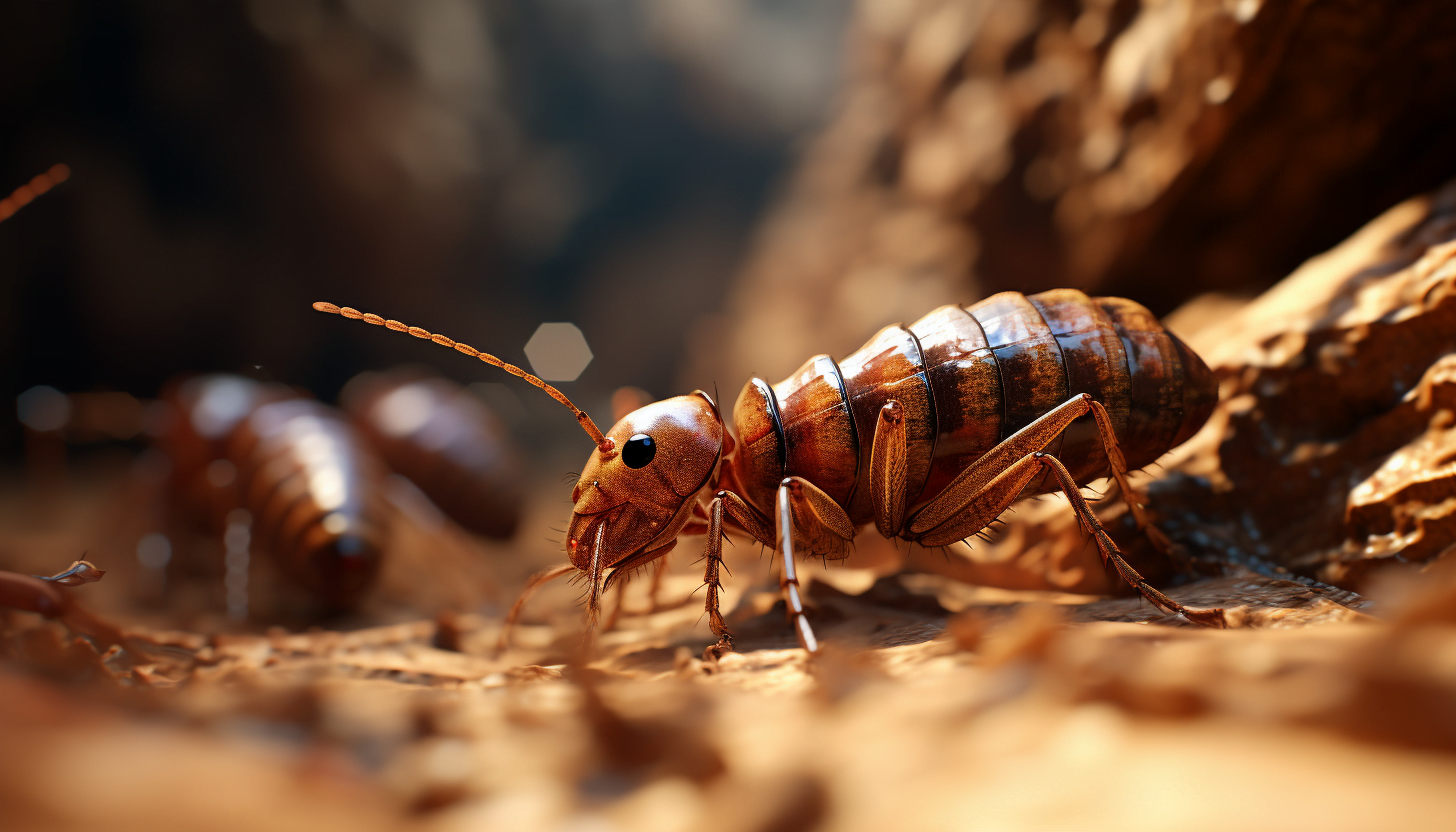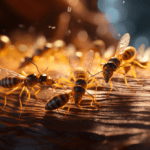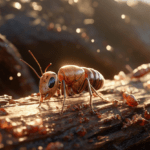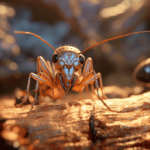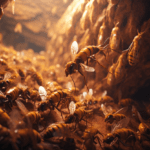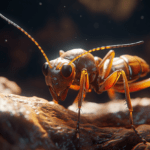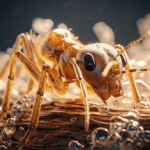Termites are fascinating insects that have a significant impact on our environment and homes. These tiny creatures feed on wood and other cellulose-based materials, causing extensive damage if left unchecked. Understanding the eating habits of termites is crucial in preventing infestations and protecting our properties. In this article, we will explore the different aspects of termite feeding habits and behaviors.
Note: Concerned about termites in your home? Learn about the Signs of a Termite Infestation in our previous article.
1. What Foods Do Termites Eat?
Termites are known for their insatiable appetite for wood. However, they are not limited to just wood; these pests can consume various cellulose-based materials. Besides ingesting structural wood, termites also feed on paper, cardboard, fabric, and even certain types of furniture. It is important to note that not all termites have the same dietary preferences. Some species of termites are more attracted to decaying wood, while others prefer freshly cut wood. By understanding their food preferences, we can better target termite control measures.
2. How Do Termites Eat Their Food?
Termites have specialized bacteria and protozoa in their guts that allow them to break down cellulose, which is otherwise indigestible by most animals. These microorganisms help break down the cellulose into smaller molecules that can be absorbed and utilized by the termites. As termites consume the wood, they create intricate tunnel systems called galleries. These galleries protect them from predators and maintain a stable environment for the colony. The termites continuously chew and swallow wood fibers, regurgitating it as a nourishing substance called “wood particles” which are then shared with other colony members.
3. What Competes with Termites for Food?
While termites may be the most notorious wood-eating insects, they are not the only ones competing for this food source. Other wood-destroying organisms such as carpenter ants and wood-boring beetles are frequent competitors. These insects can cause similar damage to wood structures, making it important to identify the specific pest affecting your property accurately. Additionally, environmental factors such as moisture levels and availability of food can also play a significant role in termite competition.
4. What Do Termites Eat During Winter?
During winter, when resources are scarce, termites seek alternative sources of food. If available, they may feed on other cellulose-rich materials present in their environment, such as fallen leaves, tree barks, or even underground roots. Some termites may even resort to cannibalism, consuming weaker members of their own colony. However, it is worth noting that termites are less active during the winter months, as they prefer warmer temperatures for optimal feeding and reproduction.
5. What Predators Hunt Termites?
Despite their reputation as destructive pests, termites have natural predators that help keep their populations in check. Some common predators of termites include ants, spiders, birds, reptiles, and even mammals. These predators have developed specialized adaptations, such as strong jaws or sticky traps, to capture and feed on termites. Natural predators play an essential role in maintaining ecological balance and preventing termite infestations in certain areas.
6. What Do Termites Look Like?
Termites are small, pale insects that resemble ants. However, there are distinct characteristics that set them apart. Unlike ants, termites have straight bodies without a segmented waist. They also have straight antennae and equal-sized wings. However, it’s important to note that not all termites have wings. Winged termites, known as swarmers or alates, are the reproductive members of the colony and are often mistaken for flying ants. Proper identification is crucial to determine the presence of termites and implement effective control measures.
7. What Are the Different Types of Termites?
Termites belong to the order Isoptera and can be classified into three main types: subterranean, drywood, and dampwood termites. Subterranean termites are the most common and destructive type. They build elaborate underground tunnels and require moisture to survive. Drywood termites, as the name suggests, infest dry wood and do not require contact with the soil. Dampwood termites thrive in moist environments and are commonly found in areas with high humidity or water damage. Understanding the different types of termites can aid in identifying the appropriate treatment method for infestations.
8. How to Identify Termites
Identifying termites can be challenging, as they often remain hidden within the structures they infest. However, there are some signs to look out for that may indicate termite activity. These include mud tubes or tunnels on the walls, swarmers or discarded wings near windows and doors, hollow-sounding wood, and droppings that resemble wood pellets. Regular inspections by trained professionals can help detect termites early and prevent significant damage.
9. Where Do Termites Live?
Termites live in colonies that can range in size from a few hundred to several million individuals. Subterranean termites build their nests underground, near or below the water table, to maintain the necessary moisture levels. They create intricate tunnel systems that allow them to access above-ground food sources without exposing themselves to the elements or predators. Drywood termites, on the other hand, reside entirely within the wood they infest. Dampwood termites live in moist environments like decaying trees or wet basements. Understanding termite habitats is essential in implementing targeted control strategies.
10. What Are the Signs That You Have Termites?
Detecting a termite infestation early can save you from costly repairs and structural damage. Look out for signs such as hollow-sounding or damaged wood, mud tubes along the walls or foundation, discarded wings, small holes in wood surfaces, and piles of wood particles (frass). If you notice any of these signs, it is crucial to contact a professional pest control service for further evaluation and treatment.
Termites: The Silent But Destructive Home Invaders
[youtube v=”gTzKyuZNDMA”]
Termites are a homeowner’s worst nightmare. These tiny pests have the ability to cause extensive damage to properties, resulting in millions of dollars in repair costs each year. While it’s no surprise that termites feast on wood, experts have discovered that they can eat much more than that. In fact, a recent study by a team of entomologists at the National Pest Management Association found that termites can devour everyday household items made of cellulose, such as shoes, books, electronics, and even money.
Cellulose is the main substance found in the plant cell wall, and it can be found in materials like wood, cotton, and paper. This means that termites have the ability to chomp through a wide range of objects made from these materials. The experts were even shocked to find that termites could make fast work of objects like burgers and fries, as they were able to completely eat through the back cover of a paperback book.
While termites are primarily known for their love of wood, this research highlights just how versatile their diet can be. It raises concerns for homeowners who may not realize that their possessions are at risk of being devoured by these silent invaders.
Understanding the scope of what termites can eat is crucial in order to protect your home and belongings. Homeowners should be aware of the potential risks and take necessary measures to prevent infestations. This new research serves as a valuable reminder that termites are not to be underestimated, and it emphasizes the importance of regular termite inspections and control measures to safeguard your property.
In conclusion, termites are not just a threat to wood, but to a wide array of objects made from cellulose. Homeowners must be vigilant and proactive in protecting their properties from this destructive pest. Regular inspections and preventive measures are essential to avoid extensive damage and costly repairs. Don’t underestimate the appetite of termites, as they can devour much more than just your wooden structures.
Conclusion
Termites are relentless wood-destroying pests that require our attention and proactive measures to prevent infestations. By understanding their feeding habits, identifying termite species, and recognizing signs of an infestation, we can protect our properties and take necessary steps to control termite populations. Regular inspections and timely intervention are key to keeping these silent invaders at bay.
FAQs
- How often do termites eat? Termites eat continuously, feeding on wood and cellulose-based materials day and night. Their feeding habits are essential for their survival and growth as a colony.
- What do termites eat during winter? During winter, termites seek alternative food sources such as fallen leaves, tree barks, and even roots. Some termites may resort to cannibalism or consume weaker colony members.
- Do termites have any predators? Yes, termites have natural predators such as ants, spiders, birds, reptiles, and mammals. These predators help regulate termite populations and prevent infestations.
- How do I identify termites? Termites have distinct features such as straight bodies, straight antennae, and equal-sized wings (in winged termites). Look for signs like mud tubes, wings, hollow-sounding wood, and droppings to identify termite activity.
- Where do termites live? Termites live in colonies and can be found in various habitats. Subterranean termites build nests underground, while drywood termites reside within the infested wood. Dampwood termites prefer moist environments like decaying trees.
- Discover the Borough of Frenchtown, NJ: A Delaware River Town Blending History, Art & Nature - November 22, 2024
- Discover Clarks Grove, MN: A Small Town with a Big Heart - November 22, 2024
- Califon Borough, NJ: A Small Town with a Big Heart (and Rich History) - November 22, 2024
